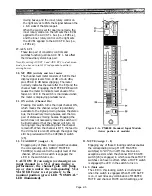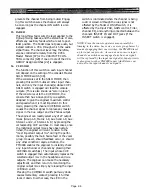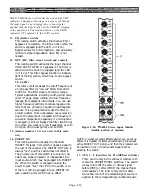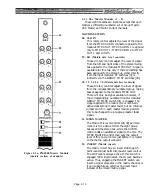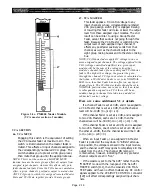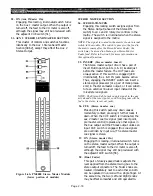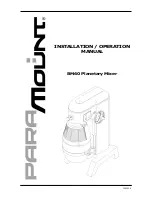
20S. MT PRE (switch) and L, R (level meters)
The channel level meters consist of two rows of 6
LEDs each that display the left and right signal
levels from -20 dB u to +6 dBu, plus PEAK (3 dB
below clipping). The meters normally indicate the
level after the EQ and the channel fader. Engag-
ing the METER PRE switch causes the meters to
indicate level before the fader. An LED in the
switch is illuminated when the meters are
displaying pre-fader level.
21. ON switch (Channel On)
Pressing this switch turns the input channel ON,
which means the channel output is potentially
available to the 8 group mixing busses, the stereo
bus, the 8 auxiliary mixing busses, and the two
pair of stereo aux mixing busses. Engaging the
switch does not necessarily mean the switch will
be illuminated or that the channel will turn on;
muting logic may be dictating that the channel
remain off. When the channel is OFF, the feed to
the VU meter is also off, although the signal may
still be previewed with the CUE/SOLO switch
[26].
22. VCA GROUP (Assign 1 - 8)
Engaging any of these 8 locking switches enables
the corresponding VCA GROUP MASTER
FADER(s) to also control the output level of this
channel. When a VCA switch is engaged, the
LED in the switch turns on.
CAUTION: If you assign (or deassign) an
input channel to a VCA group during a
performance, the channel gain will jump
up or down unless the corresponding VCA
MASTER Fader is set precisely to the
nominal position (green LED "NOMINAL"
LED illuminated).
23.
MUTE (Assign 1 - 8)
Engaging any of these 8 locking switches enables
the corresponding Group MUTE MASTER
switch(es) to "kill” (turn off) this channel. An
exception exists when the channel MUTE SAFE
switch [24] is engaged, in which case these
MUTE switches can have no effect. When a
MUTE switch is engaged, the LED in the switch
turns on.
24. S (Mute safe)
The LED in this locking switch is illuminated
when the switch is engaged. When MUTE SAFE
is on, it overrides any combination of MASTER
MUTE and channel MUTE switch settings, and
prevents the channel from being muted. Engag-
ing this switch ensures the channel will always
be on so long as the channel ON switch is also
engaged.
25. FADER
This long-throw fader sets the level applied to the
8 group mixing busses, and the stereo bus. It also
affects any auxiliary feeds which are set to post-
fader position. The Fader does not pass audio, but
instead controls a pair of VCAs through which
the left and right audio signals flow. The channel
level may, therefore, also be controlled remotely
from the 8 VCA Master Faders [47] or the VCA/
MUTE CONTROL connector [129] if one or more
of the VCA GROUP Assign switches [22] is
engaged.
26. CUE/SOLO
The function of this switch on each input channel
will depend on the setting of the console’s Master
SOLO MODE switch [48].
If the console is set to the SOLO MODE, then
pressing this switch mutes all other input chan-
nels, and only the input channel(s) whose CUE/
SOLO switch is engaged will feed the console
outputs. (This is also known as "solo in place.")
If the console is set to the CUE MODE, the
console then has a dual-priority cue system,
designed to give the engineer maximum control
and speed when it is most important. In this
mode, pressing the channel CUE/SOLO switch
causes the channel signal to replace any master
signal in the Cue output and the Phones output.
27. Solo Mute Defeat Switch
When the console is in SOLO mode and any of
the CUE/SOLO switches is engaged, muting
relays in all but the soloed channel(s) turn off
the other channels. When a stereo input mod-
ule is used for an effects return, you may wish
to have the return signal continue to be audible
even though you are soloing another channel.
In this case, you can set the stereo input
module so that its muting relay will not be
triggered by the solo logic. Insert a small
screwdriver or a nail into this hole and press it
gently to toggle a microswitch that defeats the
solo muting for the stereo module. Should you
wish to return to normal solo muting mode, just
press the switch again.
Page 2-12
Summary of Contents for PM4000
Page 1: ...PROFESSIONAL AUDIO MIXING CONSOLE PM4000 OPERATING MANUAL YAMAHA ...
Page 2: ...PM4000 OPERATING MANUAL ...
Page 7: ...Section 1 Introduction ...
Page 11: ...Section 2 Brief Operating Instruction ...
Page 47: ...Section 3 Specifications ...
Page 51: ...Dimensional Drawings PM4000 Console all versions Page 3 4 ...
Page 52: ...Page 3 5 ...
Page 53: ...Page 3 6 PM4000 Console Rear Profiles ...
Page 54: ...Module Block Diagrams See back of the manual for overall system block diagram Page 3 7 ...
Page 55: ...Page 3 8 ...
Page 56: ...Page 3 9 ...
Page 57: ...Page 3 10 ...
Page 58: ...Page 3 11 ...
Page 59: ...Page 3 12 ...
Page 60: ...Section 4 Installation Notes ...
Page 72: ...Figure 4 13 Cables For Use With Balanced Sources Page 4 12 ...
Page 79: ...SECTION 5 Gain Structure and Levels ...
Page 82: ...Figure 5 1 Dynamic Range and Headroom in Sound Systems Page 5 3 ...
Page 86: ...Section 6 Optional Functions ...
Page 106: ...Section 7 Operating Notes and Hints ...
Page 119: ...Section 8 Applications ...
Page 127: ...Section 9 Maintenance ...
Page 131: ......
Page 132: ...YAMAHA VN02300 ...








